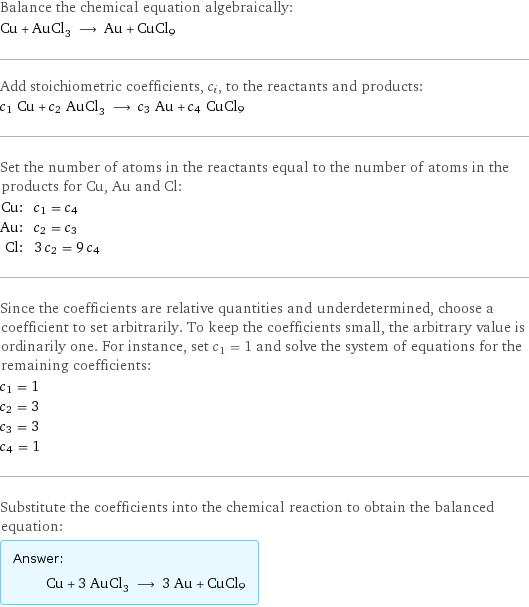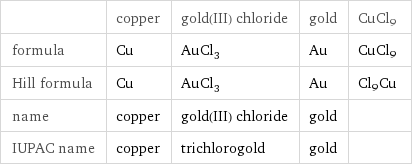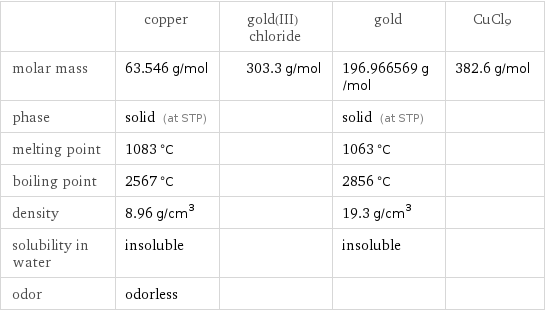Input interpretation

Cu copper + AuCl_3 gold(III) chloride ⟶ Au gold + CuCl9
Balanced equation

Balance the chemical equation algebraically: Cu + AuCl_3 ⟶ Au + CuCl9 Add stoichiometric coefficients, c_i, to the reactants and products: c_1 Cu + c_2 AuCl_3 ⟶ c_3 Au + c_4 CuCl9 Set the number of atoms in the reactants equal to the number of atoms in the products for Cu, Au and Cl: Cu: | c_1 = c_4 Au: | c_2 = c_3 Cl: | 3 c_2 = 9 c_4 Since the coefficients are relative quantities and underdetermined, choose a coefficient to set arbitrarily. To keep the coefficients small, the arbitrary value is ordinarily one. For instance, set c_1 = 1 and solve the system of equations for the remaining coefficients: c_1 = 1 c_2 = 3 c_3 = 3 c_4 = 1 Substitute the coefficients into the chemical reaction to obtain the balanced equation: Answer: | | Cu + 3 AuCl_3 ⟶ 3 Au + CuCl9
Structures

+ ⟶ + CuCl9
Names

copper + gold(III) chloride ⟶ gold + CuCl9
Equilibrium constant
![Construct the equilibrium constant, K, expression for: Cu + AuCl_3 ⟶ Au + CuCl9 Plan: • Balance the chemical equation. • Determine the stoichiometric numbers. • Assemble the activity expression for each chemical species. • Use the activity expressions to build the equilibrium constant expression. Write the balanced chemical equation: Cu + 3 AuCl_3 ⟶ 3 Au + CuCl9 Assign stoichiometric numbers, ν_i, using the stoichiometric coefficients, c_i, from the balanced chemical equation in the following manner: ν_i = -c_i for reactants and ν_i = c_i for products: chemical species | c_i | ν_i Cu | 1 | -1 AuCl_3 | 3 | -3 Au | 3 | 3 CuCl9 | 1 | 1 Assemble the activity expressions accounting for the state of matter and ν_i: chemical species | c_i | ν_i | activity expression Cu | 1 | -1 | ([Cu])^(-1) AuCl_3 | 3 | -3 | ([AuCl3])^(-3) Au | 3 | 3 | ([Au])^3 CuCl9 | 1 | 1 | [CuCl9] The equilibrium constant symbol in the concentration basis is: K_c Mulitply the activity expressions to arrive at the K_c expression: Answer: | | K_c = ([Cu])^(-1) ([AuCl3])^(-3) ([Au])^3 [CuCl9] = (([Au])^3 [CuCl9])/([Cu] ([AuCl3])^3)](../image_source/40877b6b3571ea545f66026314f81e5a.png)
Construct the equilibrium constant, K, expression for: Cu + AuCl_3 ⟶ Au + CuCl9 Plan: • Balance the chemical equation. • Determine the stoichiometric numbers. • Assemble the activity expression for each chemical species. • Use the activity expressions to build the equilibrium constant expression. Write the balanced chemical equation: Cu + 3 AuCl_3 ⟶ 3 Au + CuCl9 Assign stoichiometric numbers, ν_i, using the stoichiometric coefficients, c_i, from the balanced chemical equation in the following manner: ν_i = -c_i for reactants and ν_i = c_i for products: chemical species | c_i | ν_i Cu | 1 | -1 AuCl_3 | 3 | -3 Au | 3 | 3 CuCl9 | 1 | 1 Assemble the activity expressions accounting for the state of matter and ν_i: chemical species | c_i | ν_i | activity expression Cu | 1 | -1 | ([Cu])^(-1) AuCl_3 | 3 | -3 | ([AuCl3])^(-3) Au | 3 | 3 | ([Au])^3 CuCl9 | 1 | 1 | [CuCl9] The equilibrium constant symbol in the concentration basis is: K_c Mulitply the activity expressions to arrive at the K_c expression: Answer: | | K_c = ([Cu])^(-1) ([AuCl3])^(-3) ([Au])^3 [CuCl9] = (([Au])^3 [CuCl9])/([Cu] ([AuCl3])^3)
Rate of reaction
![Construct the rate of reaction expression for: Cu + AuCl_3 ⟶ Au + CuCl9 Plan: • Balance the chemical equation. • Determine the stoichiometric numbers. • Assemble the rate term for each chemical species. • Write the rate of reaction expression. Write the balanced chemical equation: Cu + 3 AuCl_3 ⟶ 3 Au + CuCl9 Assign stoichiometric numbers, ν_i, using the stoichiometric coefficients, c_i, from the balanced chemical equation in the following manner: ν_i = -c_i for reactants and ν_i = c_i for products: chemical species | c_i | ν_i Cu | 1 | -1 AuCl_3 | 3 | -3 Au | 3 | 3 CuCl9 | 1 | 1 The rate term for each chemical species, B_i, is 1/ν_i(Δ[B_i])/(Δt) where [B_i] is the amount concentration and t is time: chemical species | c_i | ν_i | rate term Cu | 1 | -1 | -(Δ[Cu])/(Δt) AuCl_3 | 3 | -3 | -1/3 (Δ[AuCl3])/(Δt) Au | 3 | 3 | 1/3 (Δ[Au])/(Δt) CuCl9 | 1 | 1 | (Δ[CuCl9])/(Δt) (for infinitesimal rate of change, replace Δ with d) Set the rate terms equal to each other to arrive at the rate expression: Answer: | | rate = -(Δ[Cu])/(Δt) = -1/3 (Δ[AuCl3])/(Δt) = 1/3 (Δ[Au])/(Δt) = (Δ[CuCl9])/(Δt) (assuming constant volume and no accumulation of intermediates or side products)](../image_source/2ecf37b3c067ed0a1c316d35694305f3.png)
Construct the rate of reaction expression for: Cu + AuCl_3 ⟶ Au + CuCl9 Plan: • Balance the chemical equation. • Determine the stoichiometric numbers. • Assemble the rate term for each chemical species. • Write the rate of reaction expression. Write the balanced chemical equation: Cu + 3 AuCl_3 ⟶ 3 Au + CuCl9 Assign stoichiometric numbers, ν_i, using the stoichiometric coefficients, c_i, from the balanced chemical equation in the following manner: ν_i = -c_i for reactants and ν_i = c_i for products: chemical species | c_i | ν_i Cu | 1 | -1 AuCl_3 | 3 | -3 Au | 3 | 3 CuCl9 | 1 | 1 The rate term for each chemical species, B_i, is 1/ν_i(Δ[B_i])/(Δt) where [B_i] is the amount concentration and t is time: chemical species | c_i | ν_i | rate term Cu | 1 | -1 | -(Δ[Cu])/(Δt) AuCl_3 | 3 | -3 | -1/3 (Δ[AuCl3])/(Δt) Au | 3 | 3 | 1/3 (Δ[Au])/(Δt) CuCl9 | 1 | 1 | (Δ[CuCl9])/(Δt) (for infinitesimal rate of change, replace Δ with d) Set the rate terms equal to each other to arrive at the rate expression: Answer: | | rate = -(Δ[Cu])/(Δt) = -1/3 (Δ[AuCl3])/(Δt) = 1/3 (Δ[Au])/(Δt) = (Δ[CuCl9])/(Δt) (assuming constant volume and no accumulation of intermediates or side products)
Chemical names and formulas

| copper | gold(III) chloride | gold | CuCl9 formula | Cu | AuCl_3 | Au | CuCl9 Hill formula | Cu | AuCl_3 | Au | Cl9Cu name | copper | gold(III) chloride | gold | IUPAC name | copper | trichlorogold | gold |
Substance properties

| copper | gold(III) chloride | gold | CuCl9 molar mass | 63.546 g/mol | 303.3 g/mol | 196.966569 g/mol | 382.6 g/mol phase | solid (at STP) | | solid (at STP) | melting point | 1083 °C | | 1063 °C | boiling point | 2567 °C | | 2856 °C | density | 8.96 g/cm^3 | | 19.3 g/cm^3 | solubility in water | insoluble | | insoluble | odor | odorless | | |
Units
